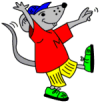 Take every opportunity to make lists with your children. Making lists and organising data into different categories continues in year 2. One key aspect is to use numbers as the source of data and organise numbers according to their properties. For example numbers can be sorted into even and odd. Children should also be able to generate their own lists of cars, sweets, girls’ names etc. as well as helping parents with shopping lists, rotas, names for a birthday party etc. Be imaginative and use every opportunity to make lists!
Take every opportunity to make lists with your children. Making lists and organising data into different categories continues in year 2. One key aspect is to use numbers as the source of data and organise numbers according to their properties. For example numbers can be sorted into even and odd. Children should also be able to generate their own lists of cars, sweets, girls’ names etc. as well as helping parents with shopping lists, rotas, names for a birthday party etc. Be imaginative and use every opportunity to make lists!
Maths worksheets: Making lists. Y2
Maths worksheets: Year 2 Making lists


 Imperial Units and quick conversion to metric.
Imperial Units and quick conversion to metric.